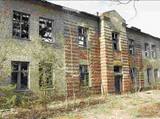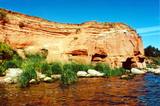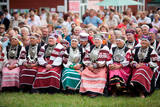| Nr | Name | Beschreibung |
|---|---|---|
|
Das Gebiet der Meereswache mit einer Abteilung der Zenitraketen in Miķeļtornis wurde spezial für die Wache der Außengrenze der UdSSR gebildet. Zur Zeit wird in diesem Territorium nur das ehemalige Grenzwachegebiet genutzt, wo sich der Beobachtungsposten des Bataillons der Küstenwache befindet.
|
||
|
This is the highest church tower in Latvia, and from it you can see views of the Alūksne highlands. The view to the South is particularly impressive.
|
||
|
Der Elkas kalna-Bauernhof befindet sich auf dem malerischen Hügel Elka – dort, wo der Fluss Gauja beginnt. Kräutertees, Birkensaft, Marmeladen und sonstige gesunde Leckereien aus lokalen Wiesen- und Gartenpflanzen. Es werden auch Natur-Werkstätten und Picknicks im Freien angeboten. |
||
|
Dieser Eisenbahnwagon ist den 2916 nach Sibirien deportierten unschuldigen Einwohnern von Skrunda und Umgebung gewidmet, die in den Viehwagen Richtung Osten abgeschoben wurden. Befindet sich nahe dem Bahnhof von Skrunda, Stacijas Straße 1. |
||
|
Atrodas 2,5 km no Bārtas centra, Bārtas upes labajā krastā. Mūsdienīgais dievnams tapis 2002. gadā (arhitekte: A. Siliņa). |
||
|
Nelielā izmēra ēka (balts ķieģeļu mūris, ar dēļiem apšūts zems tornis) atrodas Liepājas – Klaipēdas šosejas (A 11) malā. 20. gadsimta sākumā tā kalpojusi kā lūgšanu nams, taču tā paša gadsimta vidū pārbūvēta, uzceļot torni. |
||
|
This is one of the few places in the Baltic States where one can find Devonian period sandstone cliffs featuring abrasion caves, arches, etc. The cliffs are on the shores of Lake Peipsi (Peipsi järv), near Kallaste, and they are between two and four (in some cases – nine) metres high, stretching for a distance of around one km.
|
||
|
Das Schloss wurde in 1738 – 1740 un 1762 – 1772 gebaut. Der Autor des Entwurfes im Barockstil war der italienische Architekt F.B. Rastrelli. Heute befindet sich im Schloss die Lettische Landwirtschaftliche Universität. Im Untergeschoß des südostlichen Teils des Schlosses sind die Grabstätten der Herzoge von Kurland und Semgallen, des Adelsgeschlechtes Kettler und des Adelgeschlechtes Biron (1569 – 1791. mit 18 restauerierten Sarkophagen zu besichtigen. |
||
|
Der Vortrag im Hof macht die Besucher mit den im Hof gehaltenen Tieren, deren Pflege und Herkunft der Rasse bekannt. Die Besucher können zum Beispiel Eier einsammeln und lernen, wie man richtig im Sattel sitzt und reitet. |
||
|
No ūdens tūrisma attīstības centra „Bāka” skatu laukuma, kas atrodas Lubāna ezera ziemeļdaļā pie V 560 autoceļa, paveras viens no labākajiem Lubānas ezera skatiem. Redzams milzīgais Latvijas lielākā ezera klajs un Kvāpānu – Īdeņas zivju dīķu ar dambjiem ainava. |
||
|
Atrodas uz Imulas upes un celtas 19. gs. sākumā. Uz dzirnavu vārtu staba redzama tēlnieces D. Ezergailes veidota pūce. Pūces dzirnavās savulaik uzņēma pazīstamo latviešu mākslas filmu Likteņdzirnas.
|
||
|
Das Wohnhaus ist am Anfang des 18. Jhs. gebaut und in der Mitte des 19. Jhs. umgebaut worden. Immer noch werden die Erneuerungsarbeiten des Pfarrhofkomplexes durchgeführt. Seit September 2009 arbeiten in dem Pfarrhofkomplex drei Erholungshäuser des Rekollektionszentrums der Evangelisch-Lutherischen Kirche Lettlands. Neben den Häusern kann man die Reste des alten Pferdestalls sehen. |
||
|
Der Park des Gutes Stelmužė wurde Mitte des 18. Jh. südlich vom See Stelmužė angelegt. Von allen Seiten führen gewundene Pfade zu der auf dem Hügel stehenden Jesus-Kreuz-Kirche. In der Baumschicht dominieren Linden, Ahorn, Ulmen, Birken, Fichten, Eschen, Kiefern. Am Fuß des Hügels befinden sich der Glücksbrunnen und man kann die Eichenallee entlang schlendern. Prunkstück ist aber zweifellos die Stelmužė-Eiche, die älteste und dickste in Litauen wachsende Eiche und sogar eine der ältesten Eichen in Europa. Man vermutet, dass der Baum etwa 1500-2000 Jahre alt ist, der Stammdurchmesser beträgt 3,5 m (um den Stamm zu umfassen benötigt am 8 bis 9 Leute), die Höhe 23 m. |
||
|
Die erste katholische Kirche auf dem Kirchberg von Ludza war 1687 gebaut worden, diese fiel jedoch einem Brand zum Opfer. 1738 wurde eine neue Holzkirche im Barockstil erbaut, wegen ihres prächtigen Interieurs wurde sie als schönstes hölzernes Gotteshaus Lettlands bezeichnet. Diese verbrannte im großen Stadtbrand von 1938. Der Bau der jetzigen wurde 1939 begonnen, vollkommen fertiggestellt und restauriert wurde sie jedoch erst Anfang der 90er Jahre des letzten Jahrhunderts. |
||
|
The environmental object “SUITI MEETING PLACE” was established during an international arts plénière in Jūrkalne, and the originator of the idea was the musician Igo. Sculptor Ivars Miķelsons with assistants Didzis Grodzs and Juris Krafts produced the environmental object. The idea of marking out the Suiti cultural space among Gudenieki, Alsunga and Jūrkalne in nature began in 2013, when the first Suiti meeting place was established where the Gudenieki-Ēdole and Alsunga-Basi roads cross. The second meeting place was established the next year where the Kuldīga-Alsunga-Jūrkalne road crosses the town in the direction of Jūrkalne past the Alsunga centre. The third Suiti meeting place was established in Jūrkalne. The objects were established in partnership with local governments and landowners by the “Vēju sēta” association. |
||
|
Die Exposition des Museums spiegelt drei Hauptbereiche wieder: Die Geschichte des ethnografischen Ensemble „Suitu sievas“, eine für die Region der Suiten typische Wohnzimmereinrichtung mit diversen Haushaltsgeräten, sowie alte Fotografien, die die Geschichte der Stadt wiederspiegeln. Auch für die Suiten typische Volkstrachten mit unterschiedlichen Details sind zu sehen. Dazu wurde eine Weberwerkstatt eingerichtet. (Der Name „Suiti“ kommt von dem der Jesuiten, Alsunga war die einzige katholische Region im ansonsten lutherischen Kurzeme. Viele ihrer Traditionen sind bis heute ungebrochen überliefert. Anm. d. Ü.) |
||
|
Der erste Nationalpark Litauens. Gegründet für den Schutz der Landschaften und der Seen der Aukštaitija-Anhöhe, der etnographischen Dörfer und der Naturvielwalt. |
||
|
Уютное кафе в центре Тукумса. Время работы: пн. – сб. с 10:00 до 18:00; вс.- закрыто. |
||
|
(V-1279) linked Kuldīga and Alsunga before a new road was built. The lovely gravel road weaves through forests and farmland. During appropriate weather, it can be used as an alternative road to learn about the landscapes of the Suiti region. You can also bike down the road. |
||
|
Die südöstlichste Ecke Estlands ist ein Gebiet mit einzigartiger kultureller Nuance, hier lebt eine interessante ethnische Minderheit – die Setus. Infolge der historischen Lage an der Grenze ist die Seto-Kultur eine Mischung von östlichen und westlichen Kultur – die Einflüsse kann man in ihrer Sprache, im Lebensstil, in der Küche und bei der Volkstracht erkennen. Besonders einzigartig ist die Gesangstradition der Setos - bezeichnet als Leelo, die zur UNESCO-Liste der Meisterwerke des mündlichen und immateriellen Erbes gehört. Zum Kennenlernen von Setomaa eignet sich am besten die touristische Route „Seto Külävüü“ (Seto Dorfgürtel). Die Route beginnt in Võõpsu und endet in Luhamaa und passiert mehrere Dörfer. Traditionelle Seto Küche gibt es in Tsäimaja im Seto Bauernmuseum (+372 505 4673, www.setomuuseum.ee) und in Taarka Tarõ im Seto Gemeindehaus in Obinitsa (+372 5620 3374, http://taarkatare.com ). Für Gruppen Verpflegung auf Vorbestellung, beim Wunsch werden Auftritte der lokalen Chöre und Führungen angeboten. |
||






















